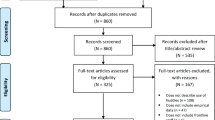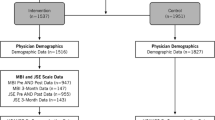Abstract
BACKGROUND
Traditional ambulatory training models have limitations in important domains, including opportunities for residents to learn, fragmentation of care delivery experience, and satisfaction with ambulatory experiences. New models of ambulatory training are needed.
AIM
To compare the impact of a traditional ambulatory training model with a templated 4 + 1 model.
SETTING
A large university-based internal medicine residency using three different training sites: a patient-centered medical home, a hospital-based ambulatory clinic, and community private practices.
PARTICIPANTS
Residents, faculty, and administrative staff.
PROGRAM DESCRIPTION
Development of a templated 4 + 1 model of residency where trainees do not attend to inpatient and outpatient responsibilities simultaneously.
PROGRAM EVALUATION
A mixed-methods analysis of survey and nominal group data measuring three primary outcomes: 1) Perception of learning opportunities and quality of faculty teaching; 2) Reported fragmentation of care delivery experience; 3) Satisfaction with ambulatory experiences. Self-reported empanelment was a secondary outcome. Residents’ learning opportunities increased (p = 0.007) but quality of faculty teaching was unchanged. Participants reported less fragmentation in the care residents provide patients in the inpatient and outpatient setting (p < 0.0001). Satisfaction with ambulatory training improved (p < 0.0001). Self-reported empanelment also increased (p < 0.0001). Results held true for residents, faculty, and staff at all three ambulatory training sites (p < 0.0001).
DISCUSSION
A 4 + 1 model increased resident time in ambulatory continuity clinic, enhanced learning opportunities, reduced fragmentation of care residents provide, and improved satisfaction with ambulatory experiences. More studies of similar models are needed to evaluate effects on additional trainee and patient outcomes.
Similar content being viewed by others
REFERENCES
Horwitz RI, Kassirer JP, Holmboe ES, et al. Internal medicine residency redesign: proposal of the Internal Medicine Working Group. Am J Med. 2011;124:806–12.
Holmboe ES, Bowen JL, Green M, Gregg J, et al. Reforming internal medicine residency training. A report from the Society of General Internal Medicine’s task force for residency reform. J Gen Intern Med. 2005;20:1165–72.
Medicare Payment Advisory Commission. Report to Congress: Improving incentives in Medicare (June 2009). Available at: http://www.medpac.gov/document_TOC.cfm?id=576. Accessed February 10, 2013.
Wynn BO, Guarino C, Morse L, Cho M. Alternative ways of financing graduate medical education. Report no. WR-369- ASPE. Santa Monica: RAND Corporation; 2006.
Accreditation Council for Graduate Medical Education. ACGME Program Requirements for Residency Education in Internal Medicine. Available at http://www.acgme.org/acgmeweb/tabid/134/ProgramandInstitutionalGuidelines/MedicalAccreditation/InternalMedicine.aspx. Accessed February 10, 2013.
Mariotti JL, Shalaby M, Fitzgibbons JP. The 4∶1 schedule: a novel template for internal medicine residencies. J Grad Med Educ. 2010;2:541–7.
Warm EJ. Interval examination: the ambulatory long block. J Gen Intern Med. 2010;25:750–2.
Dobbie A, Rhodes M, Tysinger JW, Freeman J. Using a modified nominal group technique as a curriculum evaluation tool. Fam Med. 2004;36:402–6.
Roth LM, Severson RK, Probst JC, Monsur JC, Markova T, Kushner SA, Schenk M. Exploring physician and staff perceptions of the learning environment in ambulatory residency clinics. Fam Med. 2006;38:177–84.
Thomas KG, West CP, Popkave C, Bellini LM, Weinberger SE, Kolars JC, Kogan JR. Alternative approaches to ambulatory training: internal medicine residents’ and program directors’ perspectives. J Gen Intern Med. 2009;24:904–10.
Sisson SD, Boonyasai R, Baker-Genaw K, Silverstein J. Continuity clinic satisfaction and valuation in residency training. J Gen Intern Med. 2007;22:1704–10.
Skeff KM, Stratos GA, Bergen MR. Evaluation of a medical faculty development program: a comparison of traditional pre/post and retrospective pre/post self-assessment ratings. Eval Health Prof. 1992; 15:350–366.
Bowen JL, Stearns JA, Dohner C, Blackman J, Simpson D. Defining and evaluating quality for ambulatory care educational programs. Acad Med. 1997;72:506–10.
Acknowledgements
The authors wish to acknowledge the following people for their support in the creation of the 4 + 1 model and the use of survey questions: Dr. Jeffrey Weiss, Program Director, Internal Medicine Residency at Tulane University; Dr. Marc Shalaby, Program Director, Internal Medicine Residency at Lehigh Valley; and Dr. Linda Roth, Department of Family Medicine, Wayne State University.
The authors would also like to thank the residents, chief residents, and administrative staff of the Hofstra North Shore LIJ IM Residency Program for their flexibility in transitioning to a new model of residency training and Rinkal Sundhani for her editorial assistance with this manuscript.
Conflict of Interest
The authors declare that they do not have a conflict of interest.
Author information
Authors and Affiliations
Corresponding author
Electronic supplementary material
Below is the link to the electronic supplementary material.
ESM 1
(DOCX 33 kb)
Rights and permissions
About this article
Cite this article
Chaudhry, S.I., Balwan, S., Friedman, K.A. et al. Moving Forward in GME Reform: A 4 + 1 Model of Resident Ambulatory Training. J GEN INTERN MED 28, 1100–1104 (2013). https://doi.org/10.1007/s11606-013-2387-3
Published:
Issue Date:
DOI: https://doi.org/10.1007/s11606-013-2387-3




